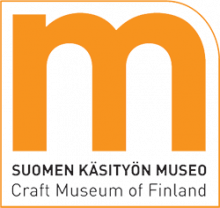Collections of the State Handicraft Museum
The current collection of the museum is founded on the Old Finnish Collection, the Russian Collection and the Foreign Collection. The domestic collection, originally assembled in 1906–1945, is currently made up of more than 3000 objects. The Old Finnish Collection has a preponderance of swatches, ribbons, and cloth squares, as well as various wood weave works such as baskets, bark containers, and bark boxes. Most of the wooden objects are boxes, containers, various household objects, and miniature models. The collection also includes some photographs originally catalogued as part of the collections of the State Handicraft Museum, the oldest of which date from the early years of the 20th century. The photographs include a wealth of pictures taken by Lauri Mäkinen on his journeys, as well as photographs such as documentation of the 1906 National Exhibition of Home Industry in Kuopio.
A collection of about 1400 black and white photographs with accompanying glass plate negatives donated by the National Agency for Vocational Education complements the Old Finnish Collection. The photographs, dating from the early 20th century until the end of the 1950s, depict crafts work, the history of crafts education, as well as crafts exhibitions and fairs. A large number of individual works and objects are also pictured.
The first library catalogue of the museum dates from 1911. The catalogue mainly consists of professional literature in German and Swedish, acquired over the years by museum intendant Lauri Mäkinen who worked with an annual budget of 1000 Finnish marks. Some of the works in the collection are genuine rarities of crafts and home industry literature from the late 19th century.
The most diverse and systematically assembled collection of Russian objects was gathered by the home industry inspector Lauri Mäkinen on his 1912 journey across Southern and Central Russia. During his trip, Mäkinen investigated the state of Russia’s home industry, documenting it through photographs. These photographs, originally the property of the Home Industry Bureau under the Finnish Agricultural Administration, were donated to the Craft Museum of Finland in the early 1980s.
Later, the Russian Collection was bolstered with acquisitions from the 1913 St. Petersburg Home Industry Exhibition. The collection includes, among others, wooden containers, vases, shelves, bark work, boxes, as well as miniature models of household and utility items. There are also plenty of textiles.
The Foreign Collection was assembled to serve as a point of comparison and a model for domestic products. The objects in the collection mainly originate from Sweden, Norway, and France. The Foreign Collection comprises about 1200 objects. The oldest part of the collection, 619 French objects, was purchased by the home industry inspector Vera Hjelt on her visit to the World’s Fair in Paris in 1889. About 420 objects of this collection remain, among them not only manufactured products but, as something of a specialty, papier-mâché works. The Nordic collection is of mixed origin. The largest share of the objects are from Norway and include tapestries and leaf-work items.
The so-called “old collection” of the State Handicraft Museum, the predecessor of the Craft Museum of Finland, is made up of several collections under different names. In its early days, the museum was administered by the Home Industry Bureau, itself a subsidiary of the Board of Trade and Industry. In 1926, the museum was transferred to the Agricultural Administration and in 1968 on to the National Agency for Vocational Education. Therefore, the museum has accumulated archive materials from all of the state agencies it has historically been part of.
The oldest documents in the archive date from the time the State Home Industry Museum operated under the Finnish Agricultural Administration. This collection takes up one metre of shelf space, and its oldest documents are letters to and from the Home Industry Bureau dating from the end of the 19th century. The most important element of the Finnish Agricultural Administration archive is a collection of 870 model drawings of furniture, tools, vehicles, and textiles. The Finnish Agricultural Administration collection also includes considerable amounts of old literature.
More information
Marjo Ahonen
curator, collections
tel. +358 50 566 2187
marjo.ahonen [at] jyvaskyla.fi

